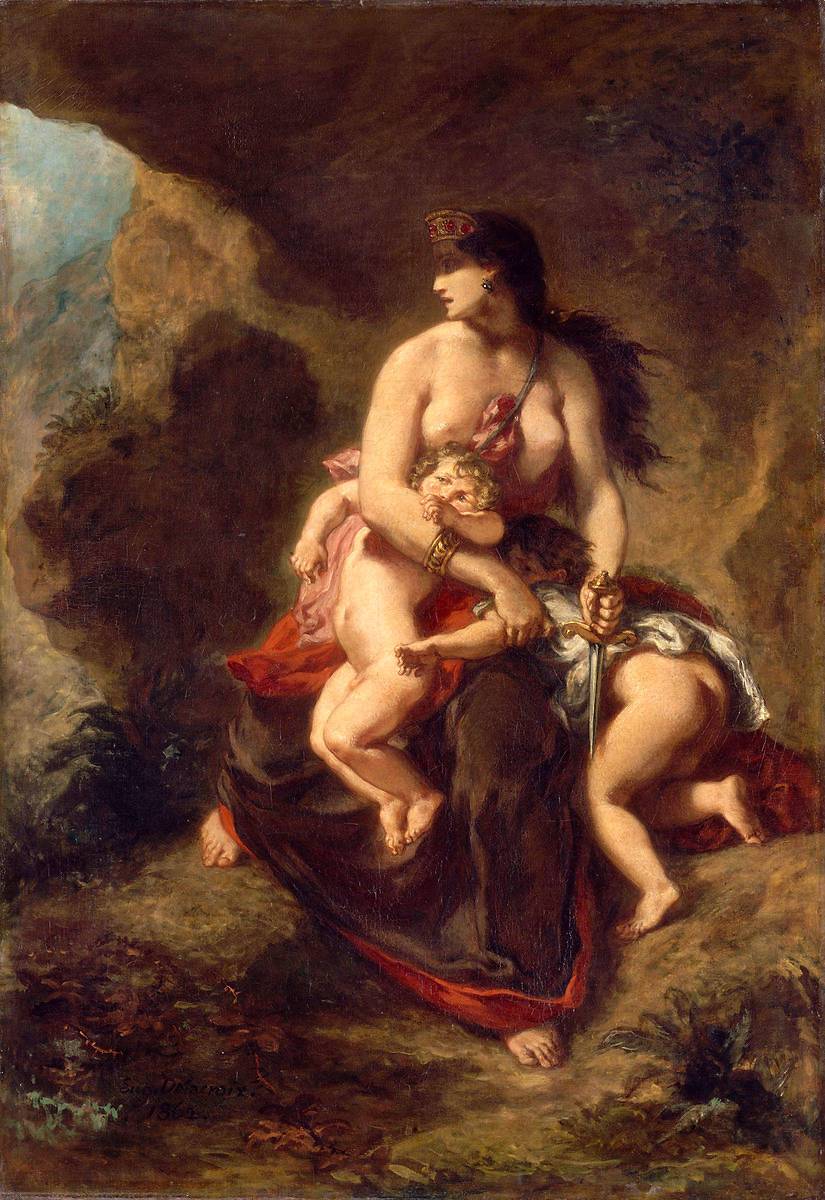Shop art print and framed art Medea by Eugène Delacroix
Customise
Your art print
Medea OF Eugène Delacroix
Medea
The mythological inspiration behind the creation of Eugène Delacroix's Médée furieuse
The Furious Medea, painted between 1836 and 1838 by Eugène Delacroix, is a major work of French Romanticism. The painting, which measures an imposing 260 cm by 165 cm and is currently housed in the Palais des Beaux-Arts in Lille, is inspired by the Greek myth of Medea, a powerful magician who, after helping Jason to conquer the Golden Fleece, is betrayed and abandoned by him. Mad with rage and grief, she decides to take revenge by murdering their two children.
Delacroix developed a passion for this subject as early as the 1820s, producing numerous sketches and preparatory studies. The theme of revenge, destructive passion and feminine madness fit perfectly with the Romantic aesthetic, which favoured strong emotions and dramatic subjects. The painter also drew inspiration from classical tragedies, particularly that of Euripides, to give his work a universal and timeless dimension.
The visual aspect of Eugène Delacroix's Médée furieuse: A scene of restrained violence
The painting depicts Medea, seated on the ground in a desolate landscape, holding her two sons in her arms at the fateful moment when she is about to commit the irreparable. Her gaze is fixed, her expression tense, reflecting an intense inner conflict. In one hand, she holds her children close to her, while in the other, she brandishes a dagger, ready to strike.
The composition is built around the central figure of Medea, towards whom all the lines of force in the painting converge. The colours, dominated by dark, earthy tones, reinforce the dramatic atmosphere of the scene. The light, coming from the left, illuminates Medea's face and the bodies of her children, creating a striking contrast with the surrounding darkness.
Médée Furieuse, a tragic and maternal figure depicted by Delacroix
Médée is depicted as a woman torn between her maternal love and her desire for revenge. Her powerful body evokes her strength and determination, while her face expresses suffering and despair. Her children, naked and vulnerable, accentuate the cruelty of her gesture.
The dagger, the only vertical element in the composition, symbolises the imminent violence. It contrasts with the rounded shapes of the children's bodies, emphasising the brutality of the act about to be committed. The desolate landscape, with its rocks and stormy sky, reflects Medea's state of mind and foreshadows the tragedy to come.
The composition of Médée Furieuse by Eugène Delacroix
Delacroix adopts a pyramidal composition centred around the main character, Medea. She occupies the centre of the pictorial space and immediately catches the eye with the senseless gesture she is about to commit with her dagger.
Delacroix contrasts warm colours (reds, oranges) with cooler hues (greyish blues), creating a visual harmony that draws the eye. The technique of chiaroscuro is also omnipresent in this work, to bring out the tension and contrasts present. This way of lighting, borrowed from the Baroque style, is used here to highlight Medea and her vengeful madness while drowning the surrounding space in heavy shadows.
The role of Médée furieuse in Eugène Delacroix's artistic career
This painting can be seen as an essential step in Delacroix's career, marked by a strong interest in Romantic themes, which characterises in particular his work on myth. The canvas captures the dramatic intensity and emotional force associated with the feeling of love and its brutality. With Médée furieuse, Delacroix reappropriated a tragic female character while exploring dark areas of human psychology. In doing so, he made a lasting mark on the French pictorial tradition by developing a style specific to his era, confirming his position as a leader of Romanticism.
As the ultimate expression of the French Romantic movement, La Médée furieuse was exhibited at the Salon of 1838, where it elicited contrasting reactions. Some critics were shocked by the violence of the subject and the raw depiction of emotions, while others praised the dramatic power of the work and Delacroix's technical mastery. The painting also had a considerable impact on art in general, paving the way for a freer and more expressive depiction of human passions. The Médée furieuse remains an iconic work today, continuing to fascinate and move viewers with its dramatic force and plastic beauty.
This artwork is a painting from the classical period. It belongs to the romanticism style.
« Medea » is kept at Louvre, Paris, France.
Find the full description of Medea by Eugène Delacroix on Wikipedia.



































